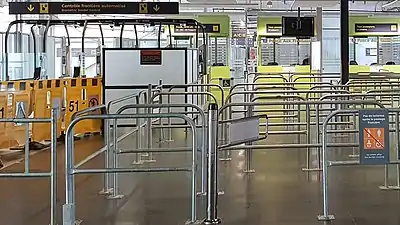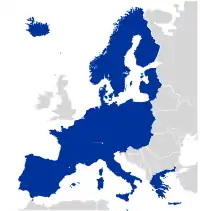Direction centrale de la police aux frontières
The Direction centrale de la police aux frontières (DCPAF) (English: Central Directorate of the Border Police), previously police de l'air et des frontières, is a directorate of the French National Police that is responsible for border control at certain border crossing points in France.[1][2] They work alongside their British counterparts (the UK Border Force) at the juxtaposed controls in Calais, and along the Channel Tunnel Rail Link with Kent Police.
| French Border Police Direction centrale de la police aux frontières | |
|---|---|
.svg.png.webp) Logo of PAF | |
| Abbreviation | PAF |
| Agency overview | |
| Formed | 1999 |
| Jurisdictional structure | |
| Operations jurisdiction | France |
| General nature | |
| Specialist jurisdiction |
|
| Operational structure | |
| Headquarters | 18, rue des Pyrénées, Paris |
| Agency executive |
|
| Parent agency | National Police |
| Website | |
| www | |

Since 1995, Customs have replaced the Border Police in carrying out immigration control at smaller border checkpoints, in particular at maritime ports and regional airports.[3][4]
Organisation
DCPAF is headed by a central director assisted by a deputy central director and includes 2 different commands:
- A central command, consisting of a staff, support services, and 3 sub-directorates;
- A territorial command, made up of DCPAF's zonal directorates.
DCPAF has 10,088 agents as of January 1, 2013.
Central Command
The central command of DCPAF, headed by a central director and senior police officers from the design and management body, is composed of:
- A staff,
- Irregular immigration and territorial services sub-directorate, to which is attached the Central Office for the Suppression of Irregular Immigration and the Employment of Untitled Foreigners (OCRIEST) which coordinates and animates the activity deployed by the investigative units (mobile research brigades - BMR) of the decentralised services,
- a Resources Branch,
- a sub-directorate for cross-border international affairs and security, in particular responsible for monitoring relations with the European Border and Coast Guard Agency (FRONTEX),
- the National Railway Police Service.
Territorial Command
The DCPAF extends its action throughout the national territory of France and overseas through a territorial network based on 7 zonal directorates (DZPAF North, DZPAF East, DZPAF South East, DZPAF South, DZPAF South West, DZPAF West, DZPAF Antilles-Guyane), 2 airport directorates (Charles De Gaulle Airport/ Paris–Le Bourget Airport), 4 directorates (DPAF New Caledonia, French Polynesia, St Pierre and Miquelon and Mayotte), 45 departmental directorates (DDPAF), 7 railway brigades, 7 poles of analysis and operational management, 10 brigades of aeronautical police. 15 administrative detention centers are controlled by the DCPAF.
References
- "Arrêté du 1er février 2011 relatif aux missions et à l'organisation de la direction centrale de la police aux frontières" (in French). Retrieved 2020-04-18.
- List of national services responsible for border-controls for the purposes of Article 15(2) of Regulation (EC) No 562/2006 of the European Parliament and of the Council of 15 March 2006 establishing a Community Code on the rules governing the movement of persons across borders (Schengen Borders Code) (C 247, 13 October 2006, p. 17)
- Center for the Study of Democracy: Study to identify best practices on the cooperation between border guards and customs administrations working at the external borders of the EU
- "Circuler en sécurité en Europe : renforcer Schengen" (in French). Senate (France). 2017-03-29. Retrieved 2020-04-18.
la PAF a-t-elle vocation à se voir attribuer les PPF au « trafic permanent significatif en provenance de pays sources d'immigration ou qui possèdent une importance justifiant une présence policière et douanière permanente »
